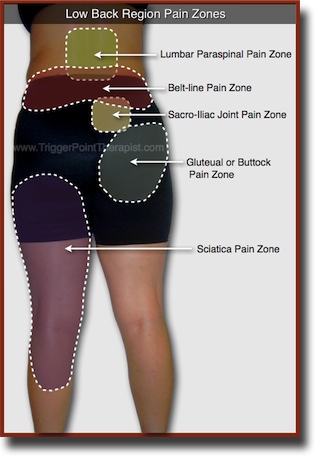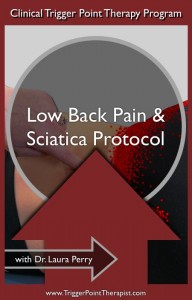 Subcategories of Low Back Pain Complaints in Trigger Point Therapy
Subcategories of Low Back Pain Complaints in Trigger Point Therapy
I’m often amused by the common use of the term “low back pain”. People typically assume it refers to one condition or disorder, but in my experience this is rarely the case. Understanding the many ways that low back pain can present itself is critical to effectively addressing it. In Clinical Trigger Point Therapy, we recognize several subcategories of the low back pain complaint:
- Pain in the Lumbar Paraspinal region: Most people associate low back pain with pain in this region, but in my practice I rarely see patients presenting with lumbar paraspinal pain. However, muscle tension in the lumbar paraspinal muscle groups is quite common and is usually caused by the ubiquitious lower-crossed postural distortion. Trigger points in the lumbar paraspinal muscles will refer pain either in the thoraco-lumbar junction and flank regions or into the gluteal region, depending on which specific muscle is involved.. Referred pain in the lumbar paraspinal region is almost exclusively produced by trigger point activity in the Ilio-Psoas muscle group.
- Pain across the Belt-line: I would estimate that 70% of the patients that come to me for low back pain complaints present with pain in the belt-line region. Often the pain presents unilaterally, but in more established complaints it can present bilaterally. The unilateral pain distribution typically involves referred pain from trigger points in the ipsilateral (i.e. on the same side) Quadratus Lumborum and Gluteus Medius muscles, whereas a bilateral pain distribution can also include a contribution from trigger point activity in the Rectus Abdominis muscle.
- Pain in and around the Sacro-Iliac Joint: Pain in the S.I. Joint region is quite common, and can be produced by trigger point activity in several muscles and by articular dysfunction in the joint itself. The S.I. joint is rather unique in that there are no muscle groups that directly act on it (or move it), but muscle tension in the adjacent muscles will often cause the joint to become displaced or dysfunctional. Trigger point activity in the Quadratus Lumborum, Gluteus Medius, and Piriformis muscles can refer pain and tenderness to the S.I. Joint. More often than not, addressing the trigger points in these muscles will alleviate S.I. joint pain, but chronic complaints may require the use of joint manipulation techniques as well.
- Pain in the Gluteal or Buttock Region: I typically see gluteal pain presentations that are secondary conditions to belt-line and sciatic pain complaints. Tenderness and pain in this region is often the result of satellite trigger point activity developing in the Gluteus Maximus muscle. Trigger points in the Gluteus Medius, Gluteus Minimus, and Bicep Femoris muscles can refer pain to the buttock region as well.
- Pain down the back or side of the leg: Pain that travels down the back or side of the leg can have several sources. First and foremost, a disc herniation in the lumbar spine can entrap the nerve roots as they exit the spine and cause radiating pain, numbness, tingling, and motor disturbances in the leg. I don’t see this condition often in practice, but when I do it is fairly obvious, as the patient will suffer from severe, unrelenting pain and present with an extreme antalgic posture. Surgery is the only viable option for these patients, and is usually very successful in my experience. The most frequent cause of sciatica symptoms, in my clinical experience, is trigger point activity in the Gluteus Minimus and Piriformis muscles. Trigger point activity in Gluteus Minimus muscle is nearly always secondary to Quadratus Lumborum trigger point activity, so I typically see patients with unaddressed cases of belt-line pain complaints develop sciatica complaints over time. Trigger point activity in the Piriformis muscle can cause the muscle to entrap the Sciatic nerve as it exits the pelvic region. This condition is called Piriformis Syndrome and is well established in the medical literature, though it occurs infrequently.
As you can see by this brief outline, the typical low back pain complaint can become a very complex disorder that involves the interaction of multiple trigger points in multiple muscle groups. Early in my practice, I was often frustrated by my inability to achieve consistent clinical results in my low back pain cases. What worked for one patient often didn’t work for another. Over the years, I learned to take a very systematic and comprehensive approach to addressing low back pain complaints, and my results improved dramatically.
Related Posts:
- How To Release The Gluteus Medius Trigger Points (Video)
- The Quadratus Lumborum Trigger Points: Masters of Low Back Pain
Related Instructional Products:
 Trigger Point DVD / Video Download: The Low Back Pain & Sciatica Protocol
Trigger Point DVD / Video Download: The Low Back Pain & Sciatica Protocol
Description: More than a decade of clinical research and experience went into developing this most effective trigger point therapy treatment protocol for the various types low back pain disorders. Mastering this comprehensive routine is the foundation of a successful trigger point therapy practice. Learn more about this DVD or video download by clicking here > Trigger Point Therapy Protocol for Low Back Pain & Sciatica.